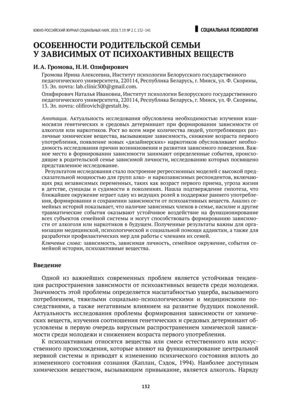Abstract
The relevance of the research is conditioned by the necessity to study the relationship between genetic and environmental determinants in the formation of alcohol and / or drug addiction. The growing number of people worldwide, who use various addictive chemicals as well as the appearance of new «designer» drugs, have necessitated the research on the causes of dependent behavior. It is mostly due to the parent family background that such behavior arises. As a result, regression models with high predictive power for groups of alcohol and drug addicts have been built. The models include a number of independent variables, such as the age of the first dose, the threat to life in childhood, suicides and prison terms in family history. A hypothesis has been confirmed that the immediate environment plays the leading role in supporting early dose and in the formation and preservation of addiction based on psychoactive substances. The analysis of parent family background has shown that the presence of addicts, violence and other traumatic events exert a steady influence upon the functioning of all subjects of the family system and can contribute to the formation of alcohol and drug addiction in future. The results obtained are important for rendering medical, psychological and social assistance to the addicted and for working out preventive/ precautionary measures to apply to the other members of the family.
Keywords
References
Бейтсон, Г. (2000). Экология разума: Избранные статьи по антропологии, психиатрии и эпистемологии. Москва: Смысл.
Варга, А.Я. (2000). Системная семейная психотерапия. В Основные направления современной психотерапии (с. 180–224). Москва: Когито-Центр.
Громова, И.А. (2017). Детерминанты зависимых и созависимых отношений: монография. Минск: БГПУ.
Каплан, Г.И., Сэдок, Б.Дж. (1994). Клиническая психиатрия: В 2 т.Т. 1. Москва.
Копытов, А.В. (2012). Алкогольная зависимость у подростков и молодых людей мужского пола (социально-психологические аспекты): монография. Минск: БГУ.
Никольская, И.М. (2010). Клиническая психология семьи: основные положения. Медицинская психология в России: электрон. науч. журн., 4. Режим доступа http://www.medpsy.ru/mprj/archiv_global/2010_4_5/nomer/nomer13.php
Олифирович, Н.И., Велента, Т.Ф. (2017). Теория семейной психотерапии: системно-аналитический подход. Москва: Академический Проект.
Теория семейных систем Мюррея Боуэна: основные понятия, методы и клиническая практика (2005) / К. Бейкер, А.Я. Варга. Москва: Когито-центр.
Черников, А.В. (1998). Генограмма и категории анализа семейной истории. Психол. конс., 1, 109–125.
Эйдемиллер, Э.Г., Юстицкис, В.В. (2008). Психология и психотерапия семьи, 4-е изд. Санкт-Петербург: Питер.
Boyle, M.H. (2001). Familial influences on substance misuse by adolescents and young adults. Canadian J. of Public Health, 92 (3), 206–209.
Brunswick, A.F. (1986). Drugs, lifestyle, and health: a longitudinal study of urban black youth. Am. J. Public Health, 76 (1), 52–57.
Choquet, M. (2008). Perceived parenting styles and tobacco, alcohol and cannabis use among french adolescents: gender and family structure differentials. Alcohol and Alcoholism, 43 (1), 73–80.
Deschenes, E.P. (1991). Narcotics addiction: related criminal careers, social and economic costs. J. of Drug Issues, 21 (2), 383–411.
Drugs and vulnerable groups of young people EMCDDA. (2008, June). Retrieved from http://www.emcdda.europa.eu/publications/selected-issues/vulnerable-young
Engel, G.L. (1980). The clinical application of the biopsychosocial model. The American J. of Psychiatry, 137 (5), 535–544.
Gibson, J.M. (1993). Use of Bowen Theory. J. of Additions and Offender Counseling, 14 (1), 25–35.
Jacobs, G.A. (1988). Personality and smokeless tobacco use. Addictive Behaviors, 13 (13), 311–318.
Jiloha, R.C. (2009). Social and Cultural Aspects of Drug Abuse in Adolescents. Delhi Psychiatry J., 12 (2), 167–175.
Krai, A.H. (1998). HIV seroprevalence among street-recruited injection drug and crack cocaine users in 16 US municipalities. Am. J. Public Health, 88 (1), 108–113.
McArdle, P. (2002). European adolescent substance use: the roles of family structure, function and gender. Addiction, 97 (3), 329–336.
Tomson, P.V. (1985). Genograms in general practice. J. of the Royal Society of Medicine Supplement, 78 (8), 34–39.

